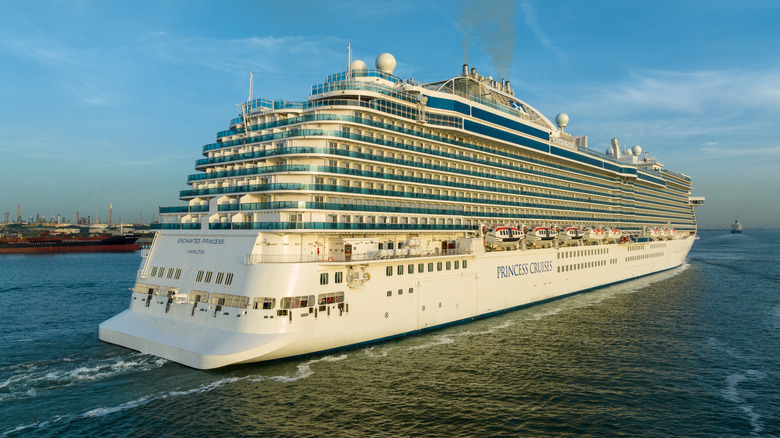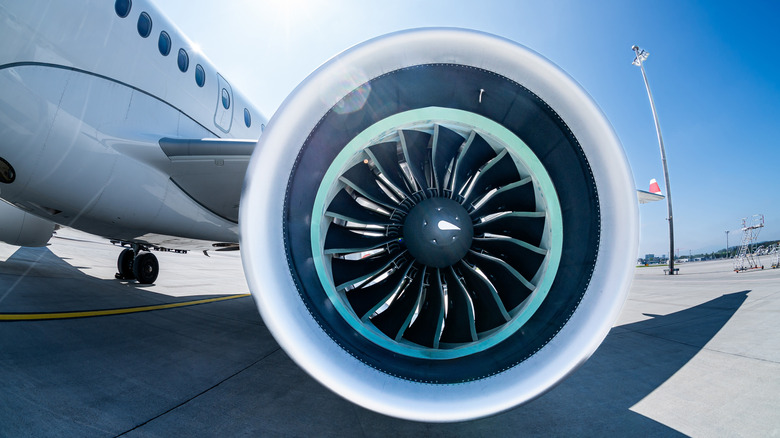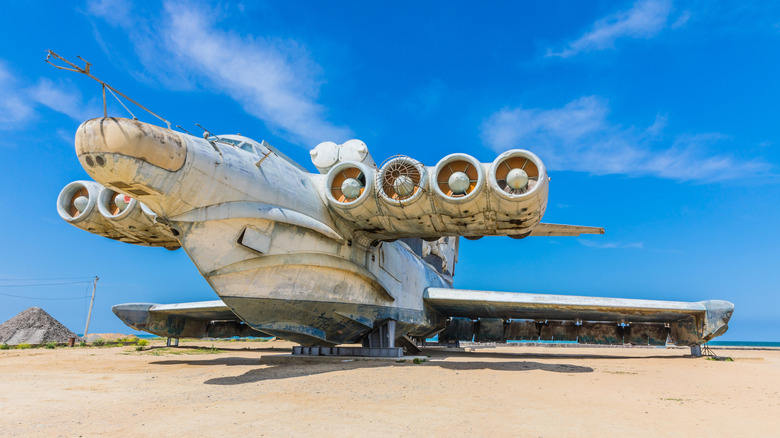Why You'll Never See A Jet Engine On A Ship
The largest ships on the water today fall into three main categories: cargo container ships, naval vessels like important and powerful aircraft carriers, and passenger cruise ships. While modern cruise ships are designed to offer luxurious accommodations, fine food, and entertainment, they are relatively slow; cruise ship speeds only average around 20 knots (23 mph). A transatlantic journey can take anywhere from 10 to 20 days on a cargo ship and around two weeks on a cruise ship, as opposed to a few hours on an airplane. This might have inspired you to wonder why ships couldn't simply strap on a few jet engines and reach airplane-like speeds?
Jet engines and large ships are incompatible for multiple reasons, though some ships use a variation of a jet engine in the form of a gas turbine system. Interestingly, the Soviet Union experimented with the idea of using jet engines to fly low over water with the Ekranoplan, although it turned out to be a dud. Let's explore why jet engines don't make sense on large ships, and the strange lesson the Soviet military learned along the way.
Jet engines
Jet engines work perfectly on airplanes, as they can provide large amounts of thrust over an extended period of time. To maximize the efficiency of the engines and minimize fuel consumption, airplanes fly thousands of feet above the ground where the air is thinner and produces less resistance, or drag.
Water is around 700 times denser and 55 times more viscous than air. Because of this, the drag experienced by ships in water is much greater than what airplanes experience in air. A jet engine wouldn't be able to propel a large ship at airplane-like speeds due to the enormous forces slowing it down, and would end up consuming excessive amounts of fuel.
Marine propulsion systems are designed to move extremely heavy ships at slower speeds using a reasonable amount of fuel. That said, some ships use gas turbine systems to drive the propellers and move the ship forward. A gas turbine engine heats compressed air by combusting fuel and uses this hot gas to spin the turbines. Whereas steam was once the standard for marine turbine engines, gas turbine engines are now the norm, especially for naval vessels. Although some shallow-water boats and personal watercraft are powered exclusively by jet engines, fuel consumption and power production differences generally force larger ships to use gas turbines in combination with diesel engines. Using jet engines on a large passenger ship would also produce a tremendous amount of noise, making the journey uncomfortable for the people on board.
The Ekranoplan was a dud
Large ships experience enormous drag due to their contact with the water, but what happens if you lift the ship out of the water? The Soviet Air Force came up with a plan to eliminate this drag by doing exactly that; building a gigantic ship/plane hybrid they called the Ekranoplan. Rather than flying thousands of feet in the air like a typical plane, the Ekranoplan aimed to ride a cushion of air above the surface, staying only about 13 feet above the water. The plane was powered by eight NK-87 jet engines and could carry six "Mosquito" anti-ship missiles. It took its name from the Russian term meaning "ground effect," the principle that allowed it to fly so close to sea level.
While the idea sounded great on paper, it failed in the real world for a variety of reasons. First, the ship could only fly above calm waters and failed when conditions were harsh. Moreover, flying the Ekranoplan this close to water was a tedious task for the pilots. The craft was hard to maneuver, and its proximity to water at high speeds posed safety risks. The Ekranoplan also had a massive turning radius, so the pilots needed to be informed well in advance of any obstacles ahead. Maintaining the plane was also difficult, as the constant spray from the salt water made its jet engines susceptible to damage. A prototype was built in 1966 and flown until 1980, when it was wrecked in a crash. A slightly advanced one-off production version was produced in 1975, and that massive plane is now stranded on a Russian beach.


